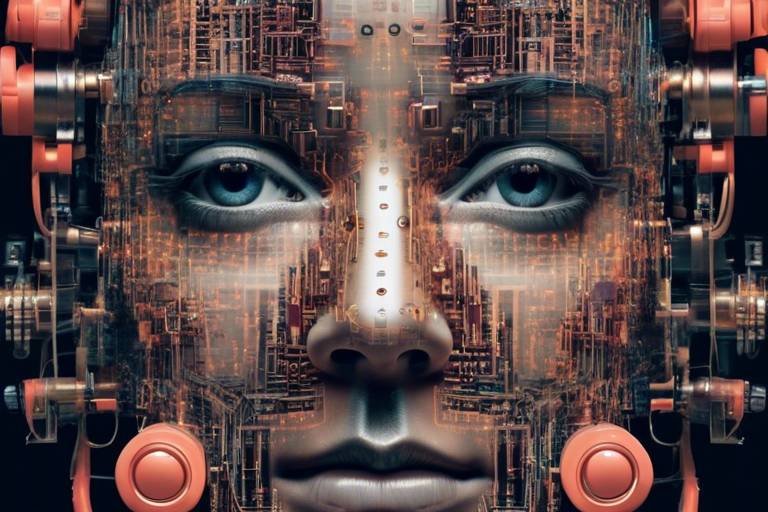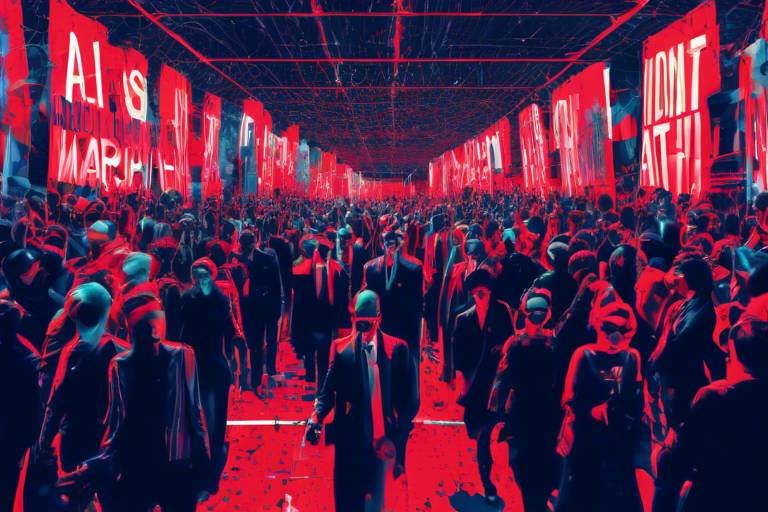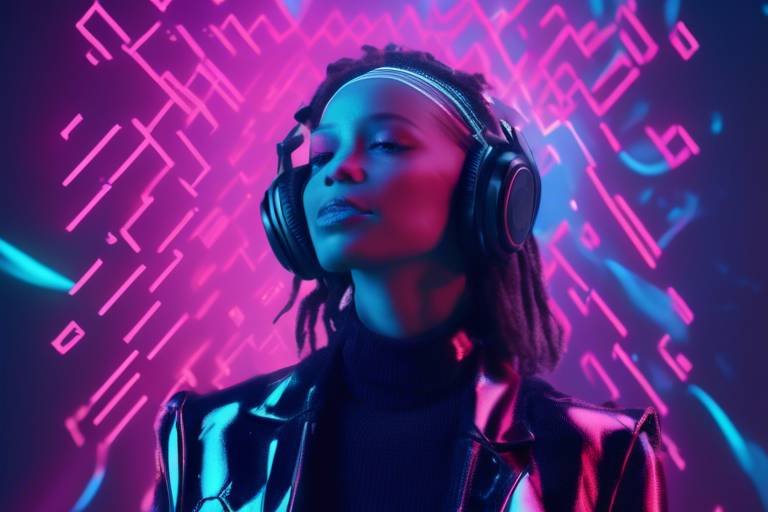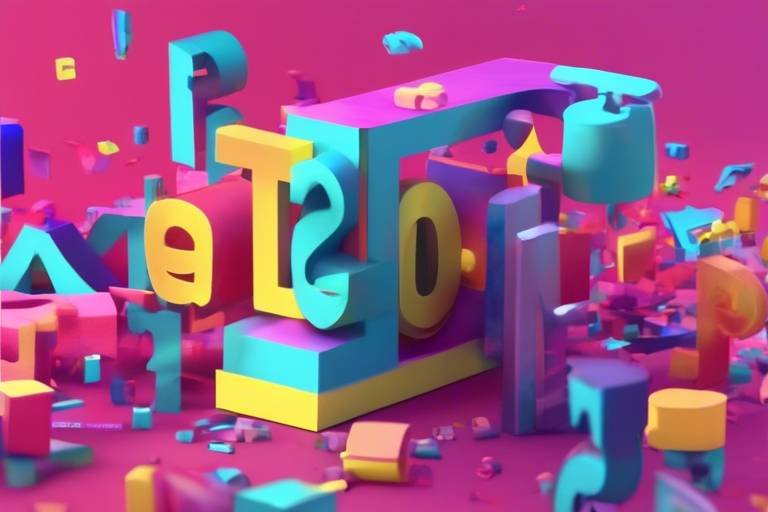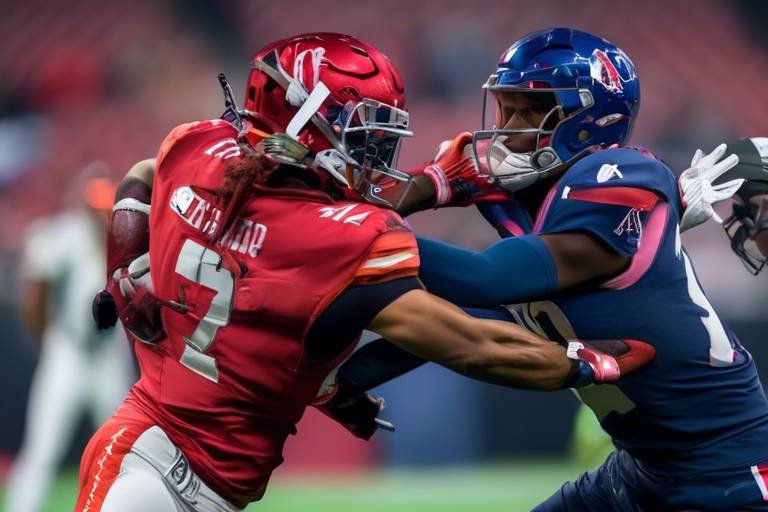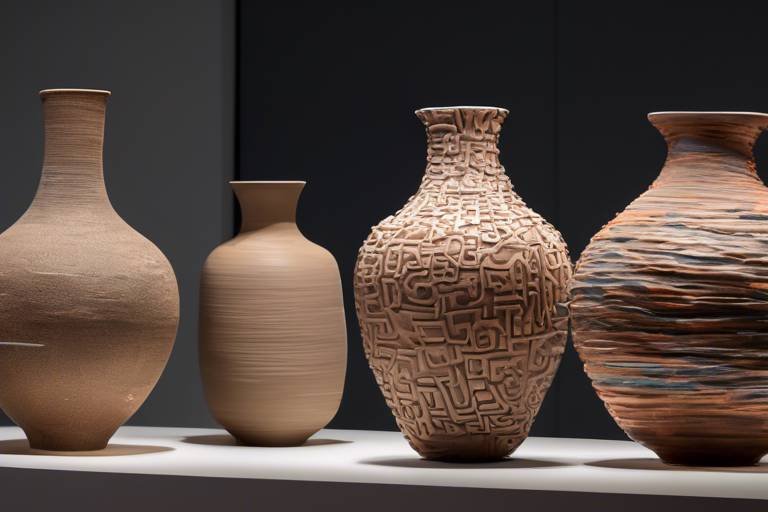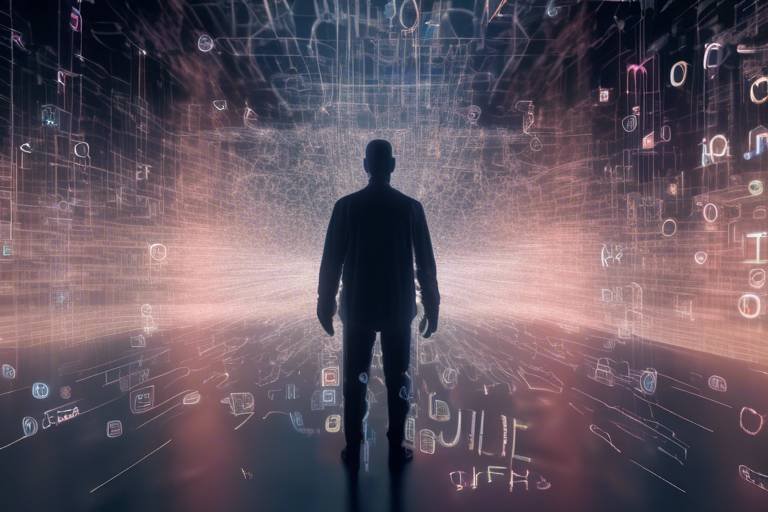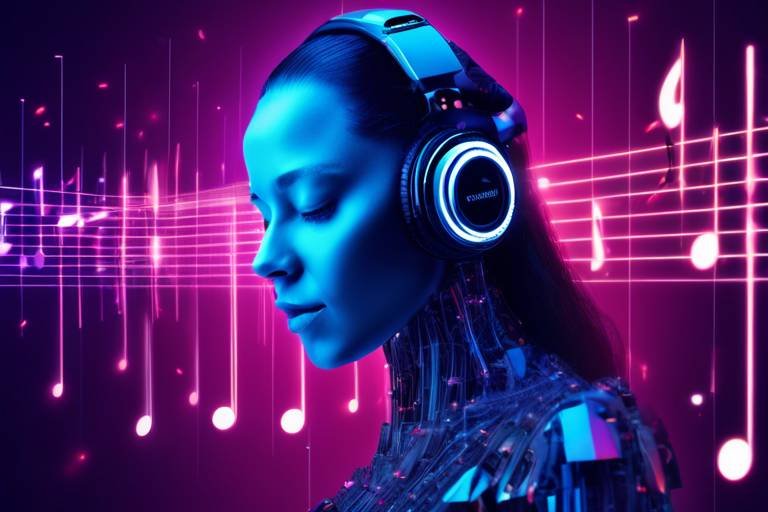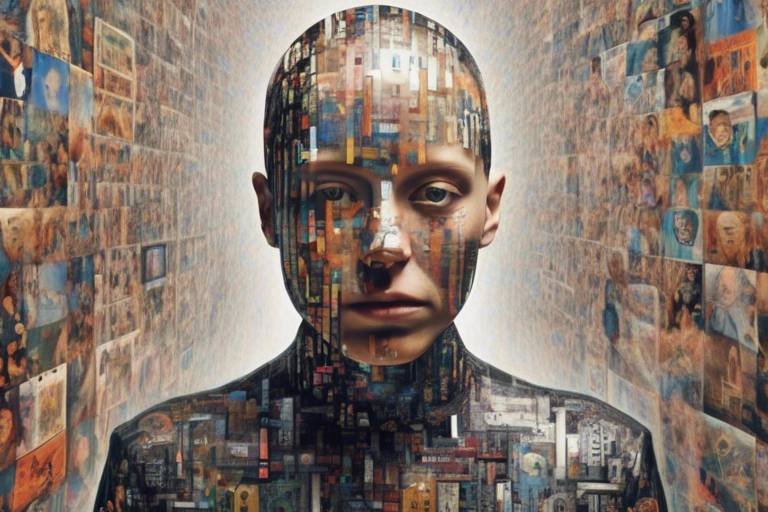Creativity in the Age of AI: New Pathways to Explore
In today's fast-paced world, the emergence of artificial intelligence (AI) is not just a technological revolution; it’s a creative one! Imagine a world where machines collaborate with humans to create stunning art, music, and literature. This article delves into how AI is reshaping creative processes across various fields, offering innovative pathways for artists, writers, and designers to explore their craft in unprecedented ways. The intersection of creativity and technology presents a thrilling landscape, where traditional boundaries are blurred, and new forms of expression are born.
Have you ever thought about how art could evolve with the help of AI? The art world is witnessing a remarkable transformation as AI technologies begin to influence the way artists create and share their work. From generating unique artworks to assisting artists in their creative processes, AI is not just a tool; it’s becoming a collaborator. Artists now have access to software that can analyze their style and suggest new ideas, leading to an explosion of creativity that challenges traditional artistic practices. This partnership between human intuition and machine learning opens up a treasure trove of possibilities.
Music is another domain where AI is making waves. Imagine being able to experiment with sounds and styles that you’ve never considered before. AI tools are revolutionizing music composition by enabling musicians to explore new sonic landscapes, collaborate with algorithms, and enhance their creative workflow without compromising their artistic integrity. But what does this mean for the future of music? Are we ready to embrace the idea of machines as co-composers?
Let’s dive deeper into the fascinating world of algorithmic composers. These are AI systems designed to create music autonomously, and their emergence is challenging our traditional understanding of authorship and creativity. When a machine composes a symphony, who gets the credit? This question is not just philosophical; it has real implications for the music industry and how we perceive creativity itself. As algorithmic composers gain popularity, they might redefine the very essence of what it means to be a musician.
Furthermore, collaborative tools powered by AI are allowing musicians to co-create in ways that were unimaginable a few years ago. Imagine jamming with a virtual band where each member is an AI-driven entity, contributing unique sounds and styles to a piece. This leads to innovative musical pieces that expand the boundaries of genre and style. The collaboration between human musicians and AI can lead to compositions that are rich, diverse, and incredibly engaging.
However, as we embrace these advancements, we must also consider the ethical implications surrounding AI-generated music. Questions about copyright, the role of human creativity, and the potential for AI to overshadow traditional musicians are critical discussions that need to happen. While AI can enhance the creative process, it’s essential to ensure that human artists are not left behind in this technological surge.
Shifting gears to the realm of literature, AI is also making its mark in creative writing. Have you ever faced writer’s block? AI can help generate story ideas, draft entire narratives, and even suggest plot twists that you might not have considered. This technology is reshaping the landscape of literature, providing writers with tools that enhance their creativity and streamline their workflow. The fusion of human imagination and AI capabilities can lead to narratives that are not only compelling but also innovative.
Now, let’s talk about visual arts and graphic design. AI is playing a pivotal role in assisting designers to create stunning visuals that captivate audiences. With AI-driven design tools, designers can streamline their workflow, allowing them to focus on the creative aspects of their work. These tools can analyze trends, suggest color palettes, and even generate layouts, making the design process more efficient and exciting. Yet, the balance between human intuition and machine learning is a delicate dance that designers must navigate.
As we explore the realm of AI-driven design tools, it’s fascinating to see how these innovations enhance the creative process. Designers can now experiment with concepts that may not have been possible before, thanks to the power of AI. This technology allows for rapid prototyping and iteration, which can lead to groundbreaking designs that push the limits of creativity.
Looking ahead, what does the future hold for graphic design in the age of AI? Technological advancements will continue to influence trends, styles, and the role of the designer. The integration of AI into design processes will likely lead to new forms of expression and collaboration, making it an exciting time for creatives. Designers who embrace these tools will find themselves at the forefront of a new creative movement.
- How is AI impacting the creative industries? AI is revolutionizing creative processes by providing tools that enhance collaboration, streamline workflows, and inspire new ideas across various fields such as art, music, and writing.
- Are AI-generated artworks considered real art? This is a topic of much debate, as AI-generated artworks challenge traditional notions of authorship and creativity, prompting discussions about what defines art.
- Can AI replace human creativity? While AI can assist and enhance creative processes, it is unlikely to fully replace the unique human touch and emotional depth that artists bring to their work.
- What ethical concerns arise from AI in creative fields? Ethical considerations include copyright issues, the potential for AI to overshadow human artists, and the need to ensure that AI tools are used responsibly in creative contexts.

The Intersection of AI and Art
In today's fast-paced world, the fusion of artificial intelligence and art is nothing short of revolutionary. Imagine walking through a gallery where each piece of art has been created with the assistance of algorithms, or perhaps even entirely by machines. This isn't just a futuristic dream; it's happening right now. AI is not merely a tool for artists; it is becoming a co-creator, challenging our perceptions of creativity and artistic expression. As we delve deeper into this intersection, we uncover a landscape filled with both opportunities and ethical dilemmas.
One of the most fascinating aspects of AI in art is its ability to generate unique artworks that can rival those made by human hands. Using complex algorithms and vast datasets, AI can analyze thousands of existing artworks, learning styles, techniques, and themes. With this knowledge, it can then create original pieces that are both innovative and thought-provoking. For instance, programs like DeepArt and Artbreeder allow users to combine different styles or even generate entirely new images based on user inputs. These tools are democratizing art creation, enabling anyone with a computer to become an artist, regardless of their traditional skills.
However, this raises an important question: what does it mean to be an artist in the age of AI? Are we diminishing the value of human creativity by allowing machines to take part in the artistic process? Or are we simply expanding the definition of art itself? The answer may lie in the collaboration between human artists and AI. Many artists are using AI as a partner rather than a replacement. They harness its capabilities to enhance their own creative processes, exploring new dimensions of their work that they might not have considered before. This partnership can lead to unexpected results, pushing the boundaries of what is possible in art.
Furthermore, the implications of AI in art extend beyond the creation of new pieces. The accessibility of these tools has also transformed how art is consumed and appreciated. For instance, galleries and museums are beginning to incorporate AI-generated art into their exhibitions, prompting discussions about authenticity and the nature of creativity. This shift challenges traditional artistic practices and invites audiences to reconsider what they value in art. Are we drawn to the skill of the artist, or do we find beauty in the ideas and concepts behind the work, regardless of who or what created it?
As we ponder these questions, it is essential to recognize the potential risks involved. The rise of AI-generated art could lead to issues surrounding copyright and ownership. Who owns a piece created by an AI? The programmer? The user? Or does it belong to the machine itself? These are complex legal and ethical questions that the art community will need to address as AI continues to evolve.
In conclusion, the intersection of AI and art is a dynamic and evolving space that offers exciting possibilities for creativity. While it challenges our traditional notions of authorship and artistic value, it also opens up new pathways for exploration and collaboration. As we embrace this new era, we must remain mindful of the implications it brings, ensuring that we maintain a balance between human intuition and the capabilities of artificial intelligence.
- What is AI-generated art? AI-generated art refers to artworks created with the assistance of artificial intelligence, often using algorithms to analyze existing styles and produce original pieces.
- Can AI replace human artists? While AI can create art, it is more commonly seen as a tool that can enhance and assist human creativity rather than replace it.
- Who owns AI-generated art? The ownership of AI-generated art is a complex issue and can depend on various factors, including copyright laws and the agreements between the creator and the AI tool.
- How is AI changing the art world? AI is transforming the art world by democratizing art creation, challenging traditional notions of authorship, and introducing new forms of artistic expression.

AI in Music Composition
The world of music is undergoing a profound transformation thanks to the advent of artificial intelligence. Imagine a scenario where a musician can collaborate with a computer algorithm to create a symphony that blends human emotion with the precision of machine learning. This is not just a dream; it's a reality that is reshaping the way we think about music composition. AI tools are now empowering musicians to explore new sounds, experiment with different genres, and enhance their creative workflows in ways that were previously unimaginable. But how exactly does this work?
AI's influence in music composition can be seen in several exciting developments. For starters, AI algorithms can analyze vast amounts of musical data—from classical masterpieces to contemporary hits—and identify patterns that might escape the human ear. This capability allows musicians to draw inspiration from a wide range of influences, leading to innovative compositions that blend various styles and traditions. In fact, many artists are now using AI as a creative partner, allowing the technology to suggest chord progressions, melodies, and even lyrics.
One of the most fascinating aspects of AI in music composition is the rise of algorithmic composers. These AI systems can autonomously create music, raising intriguing questions about authorship and creativity. For instance, can a piece of music generated by an AI truly be considered original? Or does it merely remix existing ideas? As we navigate these questions, it's clear that AI is not just a tool but a collaborator that challenges our traditional notions of what it means to create music.
Algorithmic composers are reshaping the music industry by producing tracks that can stand alongside human-created music. These systems use complex algorithms to generate melodies, harmonies, and rhythms that are often indistinguishable from those composed by people. This has led to a new genre of music, often referred to as “AI-generated music,” which is gaining popularity among listeners. However, this raises ethical dilemmas regarding copyright and ownership. If an AI creates a hit song, who owns the rights? The programmer? The user? Or the AI itself?
Moreover, AI has given rise to an array of collaborative tools that allow musicians to co-create with algorithms. These tools can take many forms, from software that suggests chord progressions to platforms that enable real-time collaboration between human musicians and AI. This collaboration leads to innovative musical pieces that push the boundaries of genre and style. For example, some musicians are using AI to blend classical music with electronic beats, creating a unique sound that resonates with diverse audiences.
As we embrace these technological advancements, it's essential to consider the ethical implications of AI in music. Questions surrounding copyright, the role of human creativity, and the potential for AI to overshadow traditional musicians are at the forefront of this discussion. While AI can enhance creativity, it also poses risks to the livelihoods of musicians who rely on their craft for income. Striking a balance between innovation and preservation of artistic integrity is crucial as we move forward in this new musical landscape.
In conclusion, AI in music composition is not just about technology; it's about redefining creativity itself. As we explore these new pathways, it’s vital to remain aware of the complexities and ethical considerations that come with this evolution. The future of music is bright, and with AI as a collaborator, the possibilities are endless.
- Can AI create original music? Yes, AI can generate music that is often indistinguishable from human-created compositions, raising questions about originality and authorship.
- How can musicians benefit from AI? Musicians can use AI tools to enhance their creativity, experiment with new sounds, and streamline their composition processes.
- What are the ethical concerns surrounding AI in music? Ethical concerns include copyright issues, the potential displacement of human musicians, and the definition of authorship in AI-generated works.

Algorithmic Composers
In the ever-evolving landscape of music, have emerged as a fascinating phenomenon, reshaping our understanding of creativity and authorship. These are not just tools for musicians; they are innovative systems that can autonomously compose music, often producing pieces that rival those created by human hands. Imagine a world where your favorite songs are not only written by artists but also by algorithms that analyze vast amounts of data to create something entirely new and unique. This intersection of technology and art raises intriguing questions about what it means to be a composer in the modern age.
At the heart of algorithmic composition lies the ability of artificial intelligence to learn from existing music. By studying patterns, structures, and styles across various genres, these systems can generate original compositions that reflect a blend of influences. For instance, a composer could input parameters such as mood, tempo, and instrumentation, and the algorithm would produce a piece that meets those criteria. This opens up a world of possibilities, allowing musicians to explore new creative territories that they might not have ventured into otherwise.
However, the rise of algorithmic composers also challenges traditional notions of authorship. If an AI creates a song, who owns the rights to that music? Is it the programmer who designed the algorithm, the AI itself, or the musician who provided the initial input? These questions are not merely academic; they have real implications for the music industry. As algorithmic composers become more prevalent, we may need to rethink our copyright laws and the way we define creativity.
Moreover, algorithmic composers can serve as collaborative partners for human musicians. They can offer suggestions, generate backing tracks, or even create entire compositions that artists can refine and personalize. This collaborative dynamic can spark new ideas and lead to innovative musical pieces that push the boundaries of genre and style. For example, a jazz musician might use an algorithm to generate complex chord progressions, which they can then improvise over, resulting in a fresh and exciting performance.
Despite the potential benefits, the integration of algorithmic composers into the music industry is not without its ethical considerations. As these systems become more sophisticated, there is a growing concern that they might overshadow traditional musicians. Will the human element of music-making be lost in a sea of algorithmically generated tunes? It’s a valid fear, especially in an industry that thrives on emotional connection and personal expression.
In conclusion, algorithmic composers represent a new frontier in music creation, blending technology with artistry in ways we are only beginning to understand. They challenge our perceptions of authorship, creativity, and collaboration. As we navigate this brave new world, it’s essential to strike a balance between embracing innovation and preserving the unique human touch that makes music so profoundly impactful.
- What is an algorithmic composer? An algorithmic composer is a system that uses artificial intelligence to create music autonomously, often analyzing existing musical data to generate original compositions.
- How does algorithmic composition work? These systems learn from patterns and structures in music, allowing them to produce new pieces based on user-defined parameters like mood and tempo.
- Who owns the rights to music created by an algorithm? Ownership can be complex and may depend on various factors, including the input provided by the musician and the design of the algorithm itself.
- Can algorithmic composers collaborate with human musicians? Yes! They can serve as creative partners, offering suggestions and generating compositions that musicians can refine and personalize.

Collaborative Tools for Musicians
In today's music landscape, the integration of artificial intelligence has opened up a realm of possibilities for collaboration that was once unimaginable. Musicians are no longer confined to traditional methods of creation; they can now partner with intelligent systems that enhance their creative output. Imagine sitting in your studio, and instead of struggling with a writer's block, you have an AI tool at your fingertips that can suggest chord progressions, melodies, or even entire arrangements. This is not just a fantasy; it's a reality that is reshaping how artists work together.
These collaborative tools often utilize machine learning algorithms to analyze vast libraries of music, identifying patterns and styles that resonate with different genres. For instance, platforms like Amper Music and AIVA allow musicians to input their preferences and generate unique compositions tailored to their vision. This means that whether you're a seasoned artist or a budding musician, you have the power to create music that reflects your style without getting bogged down by technical limitations.
Furthermore, these tools foster a sense of community among musicians. By utilizing AI-driven platforms, artists can collaborate across geographical boundaries, sharing their ideas and compositions in real-time. This not only enhances creativity but also leads to the birth of new genres and musical styles. Just think about it: a musician in New York can easily collaborate with another in Tokyo, blending their cultural influences to create something entirely fresh and innovative.
However, while these tools provide exciting opportunities, they also raise questions about the nature of collaboration itself. Are we still creating music when we rely on algorithms to make significant contributions? This leads us to consider the balance between human creativity and machine assistance. Musicians must navigate this landscape carefully, ensuring that their unique voices are not overshadowed by the technology they use. The essence of music—its emotional depth and personal touch—should always remain at the forefront of any collaborative effort.
To illustrate the impact of these tools, let's take a look at a comparison of some popular AI-driven collaborative platforms:
| Platform | Features | Best For |
|---|---|---|
| Amper Music | Customizable music creation, genre-specific templates | Content creators, filmmakers |
| AIVA | Emotion-based composition, classical music generation | Classical composers, film score creators |
| Soundtrap | Real-time collaboration, cloud-based DAW | Musicians looking for a collaborative workspace |
As we look to the future, it's clear that collaborative tools powered by AI are not just a passing trend; they are here to stay. They enable musicians to push the boundaries of their creativity, experiment with new sounds, and ultimately produce music that resonates on a deeper level with audiences worldwide. The key is to embrace these tools while maintaining the authenticity of the human experience in music-making.
- What are collaborative tools for musicians? These are platforms and software that use AI to assist musicians in creating, composing, and producing music collaboratively, often enhancing the creative process.
- Can AI replace human musicians? While AI can assist and generate music, it cannot replicate the emotional depth and unique creativity that human musicians bring to their art.
- How do I choose the right collaborative tool? Consider your specific needs, such as the type of music you create, your level of expertise, and whether you prefer real-time collaboration or generative assistance.

Ethics of AI in Music
The integration of artificial intelligence into the music industry has sparked a whirlwind of conversations surrounding ethics and creativity. As AI systems become more adept at generating music, the question arises: what does it mean for human musicians and their creative rights? One of the primary concerns is the issue of copyright. When an AI composes a piece of music, who owns the rights to that creation? Is it the programmer who designed the algorithm, the user who input the parameters, or the AI itself? These questions are not just academic; they have real-world implications for artists trying to protect their work.
Moreover, the role of human creativity is also under scrutiny. Some argue that AI-generated music lacks the emotional depth and personal touch that only a human can provide. Can a machine truly understand the nuances of human experience necessary to create resonant music? This dilemma raises the stakes for traditional musicians, who may feel overshadowed by the capabilities of AI. The fear is that as AI tools become more prevalent, they might devalue the artistry and effort that goes into human-created music.
Another ethical consideration is the potential for AI to perpetuate biases present in the data it is trained on. If an AI system learns from a dataset that lacks diversity, the music it produces could reflect and reinforce those biases, leading to a homogenization of sound. This is particularly concerning in a field that thrives on innovation and diversity. Therefore, it's crucial for developers to ensure that AI systems are trained on varied and inclusive datasets to foster a richer musical landscape.
In addition to these concerns, there is also the question of authenticity. As music becomes increasingly algorithm-driven, listeners may begin to question the authenticity of what they are hearing. Are they experiencing genuine artistic expression, or are they simply reacting to patterns generated by code? This existential question challenges both artists and audiences to reconsider their relationship with music and the creative process.
To navigate these complex ethical waters, industry stakeholders must engage in open dialogues about the role of AI in music. Establishing guidelines and frameworks can help ensure that the technology serves as a tool for enhancement rather than a replacement for human creativity. As we move forward, it’s essential to strike a balance between leveraging AI’s potential and preserving the integrity of artistic expression.
- What are the main ethical concerns surrounding AI-generated music?
The primary concerns include copyright issues, the role of human creativity, and the potential for biases in AI training data. - Can AI create music that is emotionally resonant?
While AI can generate music, many argue it lacks the emotional depth that comes from human experience. - Who owns the rights to music created by AI?
This is a complex issue, as rights could belong to the programmer, the user, or potentially the AI itself. - How can we ensure diversity in AI-generated music?
Developers need to train AI systems on diverse datasets to avoid perpetuating biases and to promote a richer musical landscape.

AI in Creative Writing
The landscape of creative writing is undergoing a radical transformation thanks to the emergence of artificial intelligence. Imagine a world where writers are not just solitary creators, but collaborators with intelligent machines that can generate ideas, suggest plot twists, and even draft entire chapters. Sounds futuristic, right? Well, it's happening now! AI tools are becoming integral to the writing process, offering authors unprecedented opportunities to enhance their storytelling capabilities.
At the heart of this revolution are sophisticated algorithms that analyze vast amounts of text to understand patterns, styles, and structures. These AI systems can generate prompts, develop characters, and even simulate dialogues, allowing writers to explore new creative avenues. For instance, a writer struggling with writer's block can input a few sentences, and the AI can generate multiple directions the story could take. This not only serves as a springboard for ideas but also helps to alleviate the pressure of perfection that many writers face.
Moreover, AI is not just a tool for generating text; it can also aid in refining and editing. Advanced AI writing assistants can analyze a piece of writing for grammar, style, and coherence, providing suggestions that can elevate a draft from mediocre to magnificent. This aspect of AI in creative writing is akin to having a personal editor available 24/7, ready to help you polish your work and ensure it resonates with readers.
However, the integration of AI into creative writing raises critical questions about authorship and originality. If an AI generates a story, who owns it? Is it the writer who provided the initial input, or the developers of the AI? This ambiguity can lead to complex ethical dilemmas, especially as AI-generated content becomes more prevalent. Writers must navigate these waters carefully, balancing the benefits of AI assistance with the need to maintain their unique voice and creative integrity.
To illustrate the impact of AI on creative writing, consider the following table that highlights some AI tools currently used by writers:
| AI Tool | Description | Key Features |
|---|---|---|
| OpenAI's GPT-3 | A powerful language model that can generate human-like text. | Text generation, conversation simulation, and idea brainstorming. |
| Grammarly | An AI-powered writing assistant that helps with grammar and style. | Real-time editing, tone detection, and clarity suggestions. |
| Sudowrite | A tool designed specifically for creative writers to enhance their stories. | Character development, plot suggestions, and sensory detail enhancement. |
As we look to the future, it's clear that AI will continue to play a significant role in shaping the art of creative writing. Writers who embrace these technologies can discover new pathways to express their ideas and connect with audiences. However, it's essential to remain mindful of the balance between leveraging AI and preserving the human touch that makes storytelling so profoundly impactful.
- Can AI replace human writers? While AI can assist in generating content, the unique human experience and emotional depth of storytelling remain irreplaceable.
- Is AI-generated writing considered plagiarism? This depends on how the AI is used. If the writer heavily edits and personalizes the AI's output, it can be original content.
- How can I start using AI for my writing? Many AI tools are available online, often with free trials. Start experimenting with prompts and see how they can enhance your writing process.

Visual Design and AI
In today's rapidly evolving technological landscape, the intersection of artificial intelligence and visual design is nothing short of revolutionary. Designers are no longer confined to traditional methods; instead, they have access to a plethora of AI-driven tools that can enhance their creative processes. Imagine being able to generate stunning visuals at the click of a button or having a digital assistant that understands your design preferences and can suggest innovative concepts tailored to your style. This is not just a futuristic dream—it's happening right now!
The role of AI in graphic design is multifaceted, encompassing everything from automated image generation to style transfer. For instance, tools like DALL-E and Midjourney allow designers to create unique images based on simple text prompts. This capability opens up a world of possibilities, enabling artists to visualize concepts that might have taken days or weeks to create manually. Additionally, AI algorithms can analyze existing design trends and suggest elements that resonate with current aesthetics, helping designers stay ahead of the curve.
However, it's not just about speed; it's also about enhancing creativity. AI can serve as a collaborative partner, providing suggestions and variations that a designer might not have considered. For example, when working on a branding project, a designer might input their primary color palette and desired mood into an AI tool, which could then generate several logo concepts based on those parameters. This kind of collaboration not only saves time but also expands the creative horizons of designers, allowing them to explore styles and ideas that they might have never encountered.
While the benefits of AI in visual design are clear, there are also challenges that need to be addressed. The balance between human intuition and machine learning is crucial. Designers must ensure that while they leverage AI tools, they do not lose the essence of their creative vision. The human touch—empathy, emotional connection, and a unique perspective—remains irreplaceable. AI can assist, but it should not dictate the creative process. The best designs often come from a blend of human insight and technological assistance.
As we look to the future, the landscape of graphic design is poised for further transformation. With advancements in machine learning and neural networks, we can expect even more sophisticated tools that will redefine the boundaries of visual creativity. Imagine a world where designers can create immersive experiences in virtual reality with the help of AI, or where personalized design becomes the norm, tailored to individual preferences and tastes. The possibilities are endless, and the future of graphic design in the age of AI promises to be as exciting as it is unpredictable.
- How is AI impacting the creative process in design? AI tools assist designers by automating repetitive tasks, providing inspiration, and generating unique design concepts based on user input.
- Can AI replace human designers? While AI can enhance and streamline the design process, it cannot replicate the emotional depth and human intuition that a designer brings to their work.
- What are some popular AI tools for graphic design? Some widely used AI tools include Adobe Sensei, Canva's Magic Resize, and tools like DALL-E for image generation.
- Are there ethical concerns regarding AI in design? Yes, ethical considerations include issues of authorship, copyright, and the potential for AI to homogenize design styles.

AI-Driven Design Tools
In the ever-evolving landscape of graphic design, are emerging as powerful allies for designers, enabling them to push the boundaries of creativity while streamlining their workflows. Imagine having a virtual assistant that can generate design variations in seconds, suggest color palettes, or even analyze design trends—all tailored to your unique style. This is not just a dream; it's the reality that AI brings to the table.
One of the most exciting aspects of these tools is their ability to learn from data. By analyzing thousands of designs, AI can identify patterns and preferences that might escape even the most seasoned designer. For instance, tools like Adobe Sensei leverage machine learning to enhance design processes, allowing designers to focus on the more creative aspects of their work rather than getting bogged down by repetitive tasks.
Moreover, AI-driven design tools are not just about efficiency; they also foster innovation. By experimenting with generative design algorithms, designers can explore a multitude of possibilities that they might not have considered otherwise. These algorithms can create numerous design iterations based on a set of parameters, effectively giving designers a broader canvas to work with. This is akin to having a brainstorming partner that never runs out of ideas!
However, it's essential to recognize that while AI can enhance creativity, it should complement, not replace, human intuition. The most successful designs often stem from a combination of human creativity and AI assistance. As designers utilize these tools, they must remain vigilant about maintaining their unique voice and vision in their work.
To illustrate the capabilities of AI-driven design tools, consider the following table showcasing some popular tools and their features:
| Tool Name | Features | Best For |
|---|---|---|
| Canva | User-friendly interface, templates, and AI suggestions | Beginners and social media graphics |
| Adobe Sensei | Smart editing, image recognition, and design automation | Professional graphic design |
| Logojoy | AI-generated logos based on user preferences | Small businesses and startups |
| Fotor | Photo editing, design templates, and AI effects | Quick edits and social media posts |
As we look to the future, the role of AI in graphic design will only continue to grow. Designers who embrace these tools will likely find themselves at the forefront of innovation, capable of creating work that is not only visually stunning but also deeply resonant with audiences. The blend of human creativity and AI efficiency could lead to a new era of design where the possibilities are truly endless.
- What are AI-driven design tools?
AI-driven design tools are software applications that utilize artificial intelligence to assist designers in creating graphics, analyzing trends, and automating repetitive tasks. - How can AI improve my design workflow?
AI can streamline your workflow by automating mundane tasks, providing design suggestions, and generating variations, allowing you to focus more on the creative aspects of your work. - Will AI replace human designers?
No, AI is intended to complement human creativity, not replace it. The most effective designs often result from a collaboration between human intuition and AI capabilities.

Future of Graphic Design
The future of graphic design is poised for a dramatic transformation as artificial intelligence continues to evolve and integrate into the creative process. Imagine a world where designers are not just creators but also collaborators with intelligent systems that can analyze trends, suggest color palettes, and even generate design elements based on user preferences. This synergy between human creativity and machine learning is not just a possibility; it's already happening, and it’s reshaping the landscape of visual arts in ways we never thought possible.
As we look ahead, several key trends are emerging that will define the future of graphic design:
- Personalization: AI algorithms can analyze user data to create highly personalized designs that resonate with individual tastes and preferences. This means that graphic designers will have to adapt to creating more tailored experiences, making their work not only visually appealing but also deeply relevant.
- Automation of Routine Tasks: With AI taking over repetitive tasks such as resizing images, creating mock-ups, or even generating basic layouts, designers can focus more on the creative aspects of their work. This shift allows for greater innovation and less time spent on mundane tasks.
- Enhanced Collaboration: AI tools facilitate collaboration among designers, clients, and even other AI systems. Imagine a design project where multiple stakeholders can contribute ideas in real-time, leading to richer and more diverse outcomes.
- New Aesthetic Possibilities: AI can generate unique patterns, textures, and even entire compositions that challenge traditional design norms. This opens up a world of aesthetic possibilities that can inspire designers to push their boundaries and explore uncharted territories.
Moreover, the rise of AI-driven design tools means that accessibility to graphic design is increasing. Individuals and small businesses that previously couldn’t afford professional design services can now utilize AI platforms to create stunning visuals. This democratization of design is exciting, as it allows for a broader range of voices and perspectives to be represented in the visual landscape.
However, with these advancements come challenges. Designers must grapple with the ethical implications of AI in their work. Questions about authorship, originality, and the role of human intuition in design will need to be addressed. As AI becomes more integrated into the creative process, the definition of what it means to be a designer will evolve. Will designers become curators of AI-generated content, or will they maintain their role as the primary creators?
In summary, the future of graphic design in the age of AI is both exhilarating and complex. As technology continues to advance, designers must embrace these changes, adapting their skills and workflows to harness the full potential of AI. The interplay between human creativity and artificial intelligence will likely lead to a new era of design, characterized by innovation, collaboration, and a redefinition of artistic expression.
Q: How will AI change the role of graphic designers?
A: AI will automate routine tasks, allowing designers to focus more on creative aspects. Designers may also become curators of AI-generated content, leading to a redefined role in the creative process.
Q: Will AI-generated designs replace human designers?
A: While AI can assist in the design process, it is unlikely to fully replace human designers. The unique perspective, intuition, and emotional intelligence that humans bring to design are irreplaceable.
Q: What are some ethical considerations regarding AI in graphic design?
A: Ethical considerations include authorship, copyright issues, and the potential for AI to overshadow human creativity. Designers must navigate these challenges as they integrate AI into their workflows.
Q: Can small businesses benefit from AI in graphic design?
A: Absolutely! AI-driven design tools make it easier and more affordable for small businesses to create professional-quality visuals, leveling the playing field in the design industry.
Frequently Asked Questions
- How is AI changing the art world?
AI is transforming the art world by enabling artists to create unique artworks through algorithms and machine learning. Artists are using AI as a tool to enhance their creative processes, allowing for new forms of expression and experimentation that were previously unimaginable.
- Can AI compose music that feels authentic?
Absolutely! AI tools are designed to assist musicians in composing music, providing them with new sounds and styles to explore. While AI can generate music autonomously, it often works best when collaborating with human musicians, blending the creativity of both to produce authentic and engaging pieces.
- What are algorithmic composers?
Algorithmic composers are AI systems that can create music independently. They analyze vast amounts of data from existing music to generate new compositions, challenging our traditional notions of authorship and creativity in the music industry.
- Are there ethical concerns with AI-generated music?
Yes, there are several ethical considerations, including copyright issues and the potential impact on human musicians. As AI-generated music becomes more prevalent, questions arise about the value of human creativity and whether AI might overshadow traditional artists.
- How is AI being used in creative writing?
AI is revolutionizing creative writing by helping writers brainstorm ideas, draft narratives, and even edit their work. This technology allows authors to explore new storytelling techniques and enhance their writing process, making it easier to generate compelling content.
- What role does AI play in graphic design?
AI plays a significant role in graphic design by providing designers with tools that streamline their workflow and inspire innovative concepts. These AI-driven design tools help artists create stunning visuals while balancing human intuition with machine learning capabilities.
- What does the future hold for graphic design in the age of AI?
The future of graphic design will likely be shaped by ongoing technological advancements, leading to new trends and styles. As AI continues to evolve, designers will need to adapt to these changes, embracing the opportunities for creativity and innovation that AI presents.



